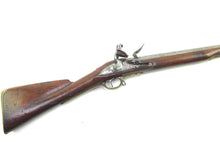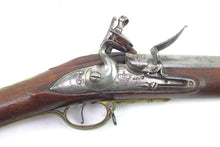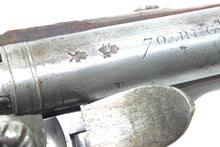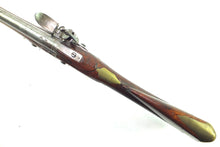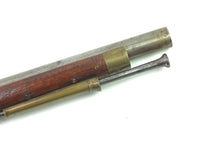
A Fine Short Land Pattern 1777 Brown Bess Musket.
Missed out on this item? Click to view all current Antique Muskets, Rifles & Sporting Guns Free UK delivery on all items
55” overall, 39 ½” barrel with Ordnance proofs and engraved ‘70th Reg’. Double border line engraved lock, with Tower on the tail and Crown over GR under the pan, and Ordnance mark. Swan neck cock, inspector’s marks & makers ‘HL’ stamped inside the lock plate. Walnut full stock with Ordnance stamps. Regulation brass furniture including long land flat sideplate, thumb piece, with a Pratt ramrod pipe. Iron ramrod.
Circa 1780
See ‘The Brown Bess’ by Erick Goldstein & Stuart Mowbray page 112-121
Good example in very good condition, shortened by 1 ½” in its working life.
Jonathan Hennem Lease Holder of Ordnance Works at Armoury Mill Lewisham Kent suppled Short Land Muskets 1793-1799. £3,995
70th Regiment of Foot 1758–1782 70th (Surrey) Regiment of Foot 1782–1812
The formation of the regiment was prompted by the expansion of the army as a result of the commencement of the Seven Years' War. On 25 August 1756 it was ordered that a number of existing regiments should raise a second battalion; among those chosen was the 31st Regiment of Foot. The 2nd Battalion of the 31st Regiment of Foot was formed on 10 December 1756 and renumbered as the 70th (Glasgow Lowland) Regiment of Foot on 21 April 1758. The regiment was sent to Ireland in 1763 and on to the West Indies in 1764 where it suffered serious losses due to illness before returning home in 1774. It embarked for North America in 1775 for service in the American Revolutionary War. It was involved in the Battle of Sullivan's Island in June 1776 and the attack on Fort Lafayette in June 1779. The regiment acquired a county designation as the 70th (Surrey) Regiment of Foot in 1782 before returning home in 1784. John Howard, 15th Earl of Suffolk, colonel of the regiment during the Napoleonic Wars, by Henry Bone
The regiment embarked for the West Indies again in 1793 for service in the French Revolutionary Wars. It took part in the Battle of Martinique in February 1794 and the Invasion of Guadeloupe in April 1794. The regiment then returned to Europe landing at Gibraltar in May 1795. It embarked for the West Indies again in February 1800 and based itself in Trinidad before arriving back in Jersey in May 1801. It embarked for the West Indies yet again in autumn 1803 and based itself in Antigua before moving to Saint Kitts in June 1806 and to Saint Thomas in December 1807. It then saw action during the Invasion of Guadeloupe in January 1810. The regiment embarked for home in June 1810 and, after moving into Ayr Barracks, reverted to the old title of 70th (Glasgow Lowland) Regiment of Foot in October 1812.
The regiment was tasked with suppressing riots in Montrose in January 1813 and, after guarding French prisoners of war in Perth for four months, embarked for Canada in August 1813. It was garrisoned in Montreal and then Cornwall on the Canadian frontier during the War of 1812. It moved to Fort George in April 1817, to Kingston in June 1819 and to Quebec in May 1821. The regiment regained its English county designation as the 70th (The Surrey) Regiment in December 1825 before returning home in September 1827








